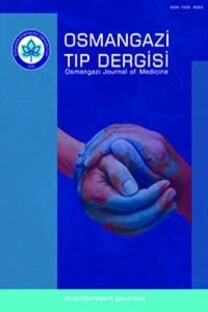Protective Effect of Carnosine on Hepatic Ischemia-Reperfusion Injury in Rats
Karaciğ er I skemisinde Karnozinin Koruyucu Etkisi
___
1. 1.Carden DL, Granger DN. Pathophysiology of ischemia-reperfusion injury. Pathol. 2000;190:255-66.2. Teoh NC, Farrell GC. Hepatic ischemiareperfusion injury: pathogenic mechanisms and basis for hepatoprotection. J Gastroenterol Hepatol. 2003;18:891-902
3. Valko M, Leibfritz D, Moncol J, Cronin MTD, Mazur M, Telser J. Free radicals and antioxidants in normal physiological functions and human disease. Int J Biochem Cell Biol. 2007;39(1):44-84.
4. Golubović S, Stanković I, Ristić L, Cosić V, Dordević I, Radović M. Antioxidant enzymes and lipid peroxidation products in patients with pulmonary tuberculosis. Med Pregl. 2010;63:450-3
5. Abdel-Gaber SA,Ibrahim MA,Amin EF,Ibrahim SA,Mohammed RK,Abdelrahman AM. Effect of selective versus non-selective cyclooxygenase inhibitors on ischemiareperfusion-induced hepatic injury in rats. Life Sci. 2015;134:42-8.
6. Fouad AA,El-Rehany MA,Maghraby HK. The hepatoprotective effect of carnosine against ischemia/reperfusion liver injury in rats. Eur J Pharmacol. 2007;572:61-8.
7. Yamashita S, Sato M, Matsumoto T. Mechanisms of carnosine-induced activation of neuronal cells. Biosci Biotechnol Biochem. 2017;11:1-6.
8. Sahin S, Burukoglu Donmez D. Effects of carnosine (Beta-Alanyl-L-Histidine) in an experimental rat model of acute kidney injury due to septic shock. Med Sci Monit. 2018;24:305-16.
9. Jamshidzadeh A, Heidari R, Latifpour Z Carnosine ameliorates liver fibrosis and hyperammonemia in cirrhotic rats. Clin Res Hepatol Gastroenterol. 2017;41:424-34.
10. Qi B, Wang J, Ma YB, Wu SG. Effect of dietary β-alanine supplementation on growth performance, meat quality, carnosine content, and gene expression of carnosine-related enzymes in broilers. Poult Sci. 2018;97:1220- 28.
11. Nakagawa K, Kawagoe M, Yoshimura M, Arata H, Minamikawa T, Nakamura M. Differential effects of flavonoid carnosine on oxidative damages induced by hydrophilic and lipophilic radical generator in hepatic lysosomal fractions of mice. J Health Science. 2000;46:509-12.
12. Peralta C, Bartrons R, Serafin A, Blazquez C, Guzman M, Prats N. Adenosine monophosphate–activated protein kinase mediates the protective effects of ischemic preconditioning on hepatic ischemiareperfusion injury in the rat. Hepatology. 2001;34:1164-73.
13. Aydın AF, Bingül İ, Küçükgergin C, DoğanEkici I, Doğru Abbasoğlu S, Uysal M.Carnosine decreased oxidation and glycation products in serum and liver of highfat diet and low-dose streptozotocin-induced diabetic rats.Int J Exp Pathol. 2017;98:278-88.
14. Schroeter R, Lankisch PG, Lege L, Vogt W. Possible implication of glutathione reductase in haemolysis by the direct lytic factor of cobra venom (Naja naja). Naunyn Schmiedebergs Arch Pharmacol. 1972;275:203-11.
15. Yabe Y, Kobayashi N, Nishihashi T, Takahashi R, Nishikawa M, Takakura Y. Prevention of neutrofil-mediated hepatic ischemia-reperfusion injury by superoxide dismutase and catalase derivatives. Journal of Pharmacology and Experimental Therapy. 2001;298:894-99.
16. Singh D, Chander V, Chopra K. The effect of carnosine, a bioflavonoid on ischemia/reperfusion induced renal injury in rats. Arch Med Res. 2008;39:714.
17. Artun BC, Küskü Kiraz Z, Güllüoğlu M, Cevikbaş U, Koçak Toker N, Uysal M. The effect of carnosine pretreatment on oxidative stress and hepatotoxicity in binge ethanol administered rats. Hum Exp Toxicol. 2010;29:659-65
18. Kalaz EB, Çoban J, Aydın AF, Doğan Ekici I, Doğru Abbasoğlu S, Öztezcan S, Uysal M. Carnosine and taurine treatments decreased oxidative stress and tissue damage induced by D-galactose in rat liver. J Physiol Biochem. 2014;70:15-25.
19. Kuloglu N, Sönmez MF. A biochemical and immunohistochemical study of the protective effects of carnosine for carbon tetrachloride induced liver injury in rats. Biotech Histochem. 2015;90:608-14.
20. Sahin S, Oter S, Burukoğlu D, Sutken E. The effects of carnosine in an experimental rat model of septic shock. Med Sci Monit Basic Res. 2013;19:54-61.
21. Yan SL, Wu ST,Yin MC, Chen HT, Chen HC. Protective effects from carnosine and histidine on acetaminophen-induced liver injury.J Food Sci. 2009;74:259-65.
22. Baykara B, Tekmen I, Pekcetin C, Ulukus C, Tuncel P, Sagol O, Ormen M, Ozogul C. The protective effects of carnosine and melatonin in ischemia-reperfusion injury in the rat liver. Acta Histochem. 2009;111:42-51.
23. Başaran Küçükgergin C, Bingül I, Tekkeşin MS, Olgaç V, Doğru Abbasoğlu S, Uysal M. Effects of carnosine, taurine, and betaine pretreatments on diethylnitrosamine-induced oxidative stress and tissue injury in rat liver. Toxicol Ind Health. 2016;32:1405-13.
24. Bingül İ, Yılmaz Z, Aydın AF, Çoban J, Doğru-Abbasoğlu S, Uysal M1.Antiglycation and anti-oxidant efficiency of carnosine in the plasma and liver of aged rats.Geriatr Gerontol Int. 2017;17:2610-14.
25. Welker AF, Moreira DC, Hermes-Lima M. Roles of catalase and glutathione peroxidase in the tolerance of a pulmonate gastropod to anoxia and reoxygenation. J Comp Physiol B. 2016; 186: 553-68.
26. Prokopieva VD, Yarygina EG, Bokhan NA, Ivanova SA Use of Carnosine for Oxidative Stress Reduction in Different Pathologies.Oxid Med Cell Longev. 2016; 2016: 2939087.
- ISSN: 1305-4953
- Yayın Aralığı: 6
- Başlangıç: 2013
- Yayıncı: Eskişehir Osmangazi Üniversitesi Rektörlüğü
Vitamin D’nin Hepatoselü ler Karsinom Ü zerindeki Etkisi
ÇAĞRI ÖNER, Hatice İSAN, Ranan Gülhan AKTAŞ, Ertugrul COLAK
Radyasyon Onkolojisinde Makine O g renmesi
Machine Learning in Radiation Oncology
Atypically Located Basal Cell Carcinoma: Three Case Reports
Ebru KARAGÜN, Mehmet GAMSIZKAN, Yavuz EYUP, Atike BAHCİVAN, Yunus ÖZCAN, Seyma BUYUCEK
Yasemin KARAL, Serap Tevhide KARASALİHOĞLU, Nilda TURGUT, Cevat Naci ÖNER, Filiz TÜTÜNCÜLER
Güler BALCI APLARSLAN, Esra BİLEN
Çocuk Yoğ un Bakım Ü nitesinde Kandidemi ve Risk Fakto rleri
Mutlu UYSAL YAZICI, Ebru AZAPAĞASI, Erhan ÖZEL, Furkan DONBALOĞLU, Selman KESİCİ, Fatma Nur ÖZ
Merih ÖZGEN, Didem Turgut COŞAN, Zeliha ATİK, Faruk SAYDAM, Emine ÇOLAK, Ahu SOYOCAK, Fulya DOĞANER, Funda BERKAN, İrfan DEĞİRMENCİ, FEZAN MUTLU
Vertikal Kaymalarda Orta Do nem Şaşılık Cerrahisi Sonuçlarımız
Onur Ozalp, Haluk Huseyin Gursoy, Ayse Idil Cakmak, Omur Can Ozdemir, Ertugrul Colak
